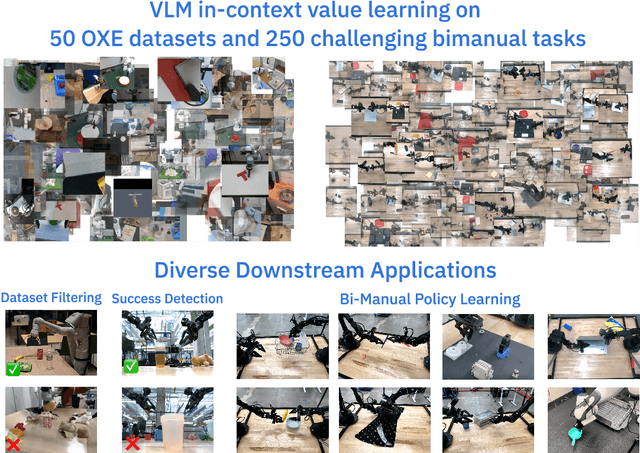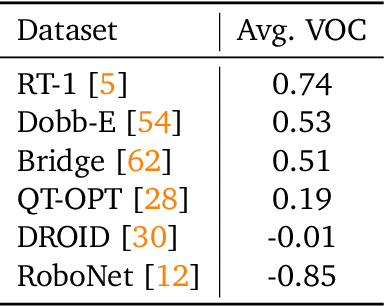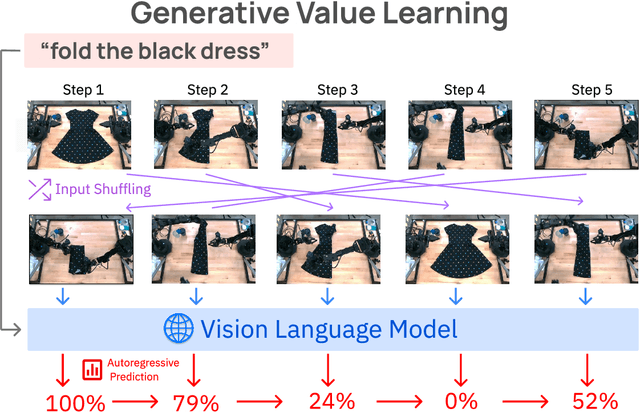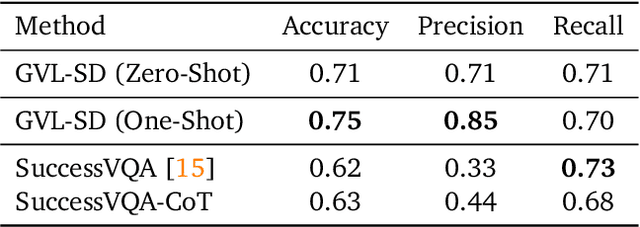Fei Xia
Google DeepMind
Bridging Perception and Action: Spatially-Grounded Mid-Level Representations for Robot Generalization
Jun 06, 2025Abstract:In this work, we investigate how spatially grounded auxiliary representations can provide both broad, high-level grounding as well as direct, actionable information to improve policy learning performance and generalization for dexterous tasks. We study these mid-level representations across three critical dimensions: object-centricity, pose-awareness, and depth-awareness. We use these interpretable mid-level representations to train specialist encoders via supervised learning, then feed them as inputs to a diffusion policy to solve dexterous bimanual manipulation tasks in the real world. We propose a novel mixture-of-experts policy architecture that combines multiple specialized expert models, each trained on a distinct mid-level representation, to improve policy generalization. This method achieves an average success rate that is 11% higher than a language-grounded baseline and 24 percent higher than a standard diffusion policy baseline on our evaluation tasks. Furthermore, we find that leveraging mid-level representations as supervision signals for policy actions within a weighted imitation learning algorithm improves the precision with which the policy follows these representations, yielding an additional performance increase of 10%. Our findings highlight the importance of grounding robot policies not only with broad perceptual tasks but also with more granular, actionable representations. For further information and videos, please visit https://mid-level-moe.github.io.
PointArena: Probing Multimodal Grounding Through Language-Guided Pointing
May 15, 2025Abstract:Pointing serves as a fundamental and intuitive mechanism for grounding language within visual contexts, with applications spanning robotics, assistive technologies, and interactive AI systems. While recent multimodal models have started to support pointing capabilities, existing benchmarks typically focus only on referential object localization tasks. We introduce PointArena, a comprehensive platform for evaluating multimodal pointing across diverse reasoning scenarios. PointArena comprises three components: (1) Point-Bench, a curated dataset containing approximately 1,000 pointing tasks across five reasoning categories; (2) Point-Battle, an interactive, web-based arena facilitating blind, pairwise model comparisons, which has already gathered over 4,500 anonymized votes; and (3) Point-Act, a real-world robotic manipulation system allowing users to directly evaluate multimodal model pointing capabilities in practical settings. We conducted extensive evaluations of both state-of-the-art open-source and proprietary multimodal models. Results indicate that Molmo-72B consistently outperforms other models, though proprietary models increasingly demonstrate comparable performance. Additionally, we find that supervised training specifically targeting pointing tasks significantly enhances model performance. Across our multi-stage evaluation pipeline, we also observe strong correlations, underscoring the critical role of precise pointing capabilities in enabling multimodal models to effectively bridge abstract reasoning with concrete, real-world actions. Project page: https://pointarena.github.io/
Chain-of-Modality: Learning Manipulation Programs from Multimodal Human Videos with Vision-Language-Models
Apr 17, 2025Abstract:Learning to perform manipulation tasks from human videos is a promising approach for teaching robots. However, many manipulation tasks require changing control parameters during task execution, such as force, which visual data alone cannot capture. In this work, we leverage sensing devices such as armbands that measure human muscle activities and microphones that record sound, to capture the details in the human manipulation process, and enable robots to extract task plans and control parameters to perform the same task. To achieve this, we introduce Chain-of-Modality (CoM), a prompting strategy that enables Vision Language Models to reason about multimodal human demonstration data -- videos coupled with muscle or audio signals. By progressively integrating information from each modality, CoM refines a task plan and generates detailed control parameters, enabling robots to perform manipulation tasks based on a single multimodal human video prompt. Our experiments show that CoM delivers a threefold improvement in accuracy for extracting task plans and control parameters compared to baselines, with strong generalization to new task setups and objects in real-world robot experiments. Videos and code are available at https://chain-of-modality.github.io
A Scoping Review of Natural Language Processing in Addressing Medically Inaccurate Information: Errors, Misinformation, and Hallucination
Apr 16, 2025Abstract:Objective: This review aims to explore the potential and challenges of using Natural Language Processing (NLP) to detect, correct, and mitigate medically inaccurate information, including errors, misinformation, and hallucination. By unifying these concepts, the review emphasizes their shared methodological foundations and their distinct implications for healthcare. Our goal is to advance patient safety, improve public health communication, and support the development of more reliable and transparent NLP applications in healthcare. Methods: A scoping review was conducted following PRISMA guidelines, analyzing studies from 2020 to 2024 across five databases. Studies were selected based on their use of NLP to address medically inaccurate information and were categorized by topic, tasks, document types, datasets, models, and evaluation metrics. Results: NLP has shown potential in addressing medically inaccurate information on the following tasks: (1) error detection (2) error correction (3) misinformation detection (4) misinformation correction (5) hallucination detection (6) hallucination mitigation. However, challenges remain with data privacy, context dependency, and evaluation standards. Conclusion: This review highlights the advancements in applying NLP to tackle medically inaccurate information while underscoring the need to address persistent challenges. Future efforts should focus on developing real-world datasets, refining contextual methods, and improving hallucination management to ensure reliable and transparent healthcare applications.
Gemini Robotics: Bringing AI into the Physical World
Mar 25, 2025Abstract:Recent advancements in large multimodal models have led to the emergence of remarkable generalist capabilities in digital domains, yet their translation to physical agents such as robots remains a significant challenge. This report introduces a new family of AI models purposefully designed for robotics and built upon the foundation of Gemini 2.0. We present Gemini Robotics, an advanced Vision-Language-Action (VLA) generalist model capable of directly controlling robots. Gemini Robotics executes smooth and reactive movements to tackle a wide range of complex manipulation tasks while also being robust to variations in object types and positions, handling unseen environments as well as following diverse, open vocabulary instructions. We show that with additional fine-tuning, Gemini Robotics can be specialized to new capabilities including solving long-horizon, highly dexterous tasks, learning new short-horizon tasks from as few as 100 demonstrations and adapting to completely novel robot embodiments. This is made possible because Gemini Robotics builds on top of the Gemini Robotics-ER model, the second model we introduce in this work. Gemini Robotics-ER (Embodied Reasoning) extends Gemini's multimodal reasoning capabilities into the physical world, with enhanced spatial and temporal understanding. This enables capabilities relevant to robotics including object detection, pointing, trajectory and grasp prediction, as well as multi-view correspondence and 3D bounding box predictions. We show how this novel combination can support a variety of robotics applications. We also discuss and address important safety considerations related to this new class of robotics foundation models. The Gemini Robotics family marks a substantial step towards developing general-purpose robots that realizes AI's potential in the physical world.
MEDEC: A Benchmark for Medical Error Detection and Correction in Clinical Notes
Dec 26, 2024Abstract:Several studies showed that Large Language Models (LLMs) can answer medical questions correctly, even outperforming the average human score in some medical exams. However, to our knowledge, no study has been conducted to assess the ability of language models to validate existing or generated medical text for correctness and consistency. In this paper, we introduce MEDEC (https://github.com/abachaa/MEDEC), the first publicly available benchmark for medical error detection and correction in clinical notes, covering five types of errors (Diagnosis, Management, Treatment, Pharmacotherapy, and Causal Organism). MEDEC consists of 3,848 clinical texts, including 488 clinical notes from three US hospital systems that were not previously seen by any LLM. The dataset has been used for the MEDIQA-CORR shared task to evaluate seventeen participating systems [Ben Abacha et al., 2024]. In this paper, we describe the data creation methods and we evaluate recent LLMs (e.g., o1-preview, GPT-4, Claude 3.5 Sonnet, and Gemini 2.0 Flash) for the tasks of detecting and correcting medical errors requiring both medical knowledge and reasoning capabilities. We also conducted a comparative study where two medical doctors performed the same task on the MEDEC test set. The results showed that MEDEC is a sufficiently challenging benchmark to assess the ability of models to validate existing or generated notes and to correct medical errors. We also found that although recent LLMs have a good performance in error detection and correction, they are still outperformed by medical doctors in these tasks. We discuss the potential factors behind this gap, the insights from our experiments, the limitations of current evaluation metrics, and share potential pointers for future research.
Test-time Correction with Human Feedback: An Online 3D Detection System via Visual Prompting
Dec 10, 2024Abstract:This paper introduces Test-time Correction (TTC) system, a novel online 3D detection system designated for online correction of test-time errors via human feedback, to guarantee the safety of deployed autonomous driving systems. Unlike well-studied offline 3D detectors frozen at inference, TTC explores the capability of instant online error rectification. By leveraging user feedback with interactive prompts at a frame, e.g., a simple click or draw of boxes, TTC could immediately update the corresponding detection results for future streaming inputs, even though the model is deployed with fixed parameters. This enables autonomous driving systems to adapt to new scenarios immediately and decrease deployment risks reliably without additional expensive training. To achieve such TTC system, we equip existing 3D detectors with Online Adapter (OA) module, a prompt-driven query generator for online correction. At the core of OA module are visual prompts, images of missed object-of-interest for guiding the corresponding detection and subsequent tracking. Those visual prompts, belonging to missed objects through online inference, are maintained by the visual prompt buffer for continuous error correction in subsequent frames. By doing so, TTC consistently detects online missed objects and immediately lowers driving risks. It achieves reliable, versatile, and adaptive driving autonomy. Extensive experiments demonstrate significant gain on instant error rectification over pre-trained 3D detectors, even in challenging scenarios with limited labels, zero-shot detection, and adverse conditions. We hope this work would inspire the community to investigate online rectification systems for autonomous driving post-deployment. Code would be publicly shared.
SIESEF-FusionNet: Spatial Inter-correlation Enhancement and Spatially-Embedded Feature Fusion Network for LiDAR Point Cloud Semantic Segmentation
Nov 11, 2024Abstract:The ambiguity at the boundaries of different semantic classes in point cloud semantic segmentation often leads to incorrect decisions in intelligent perception systems, such as autonomous driving. Hence, accurate delineation of the boundaries is crucial for improving safety in autonomous driving. A novel spatial inter-correlation enhancement and spatially-embedded feature fusion network (SIESEF-FusionNet) is proposed in this paper, enhancing spatial inter-correlation by combining inverse distance weighting and angular compensation to extract more beneficial spatial information without causing redundancy. Meanwhile, a new spatial adaptive pooling module is also designed, embedding enhanced spatial information into semantic features for strengthening the context-awareness of semantic features. Experimental results demonstrate that 83.7% mIoU and 97.8% OA are achieved by SIESEF-FusionNet on the Toronto3D dataset, with performance superior to other baseline methods. A value of 61.1% mIoU is reached on the semanticKITTI dataset, where a marked improvement in segmentation performance is observed. In addition, the effectiveness and plug-and-play capability of the proposed modules are further verified through ablation studies.
Vision Language Models are In-Context Value Learners
Nov 07, 2024



Abstract:Predicting temporal progress from visual trajectories is important for intelligent robots that can learn, adapt, and improve. However, learning such progress estimator, or temporal value function, across different tasks and domains requires both a large amount of diverse data and methods which can scale and generalize. To address these challenges, we present Generative Value Learning (\GVL), a universal value function estimator that leverages the world knowledge embedded in vision-language models (VLMs) to predict task progress. Naively asking a VLM to predict values for a video sequence performs poorly due to the strong temporal correlation between successive frames. Instead, GVL poses value estimation as a temporal ordering problem over shuffled video frames; this seemingly more challenging task encourages VLMs to more fully exploit their underlying semantic and temporal grounding capabilities to differentiate frames based on their perceived task progress, consequently producing significantly better value predictions. Without any robot or task specific training, GVL can in-context zero-shot and few-shot predict effective values for more than 300 distinct real-world tasks across diverse robot platforms, including challenging bimanual manipulation tasks. Furthermore, we demonstrate that GVL permits flexible multi-modal in-context learning via examples from heterogeneous tasks and embodiments, such as human videos. The generality of GVL enables various downstream applications pertinent to visuomotor policy learning, including dataset filtering, success detection, and advantage-weighted regression -- all without any model training or finetuning.
AutoGameUI: Constructing High-Fidelity Game UIs via Multimodal Learning and Interactive Web-Based Tool
Nov 06, 2024Abstract:We introduce an innovative system, AutoGameUI, for efficiently constructing cohesive user interfaces in game development. Our system is the first to address the coherence issue arising from integrating inconsistent UI and UX designs, typically leading to mismatches and inefficiencies. We propose a two-stage multimodal learning pipeline to obtain comprehensive representations of both UI and UX designs, and to establish their correspondences. Through the correspondences, a cohesive user interface is automatically constructed from pairwise designs. To achieve high-fidelity effects, we introduce a universal data protocol for precise design descriptions and cross-platform applications. We also develop an interactive web-based tool for game developers to facilitate the use of our system. We create a game UI dataset from actual game projects and combine it with a public dataset for training and evaluation. Our experimental results demonstrate the effectiveness of our system in maintaining coherence between the constructed interfaces and the original designs.
 Add to Chrome
Add to Chrome Add to Firefox
Add to Firefox Add to Edge
Add to Edge